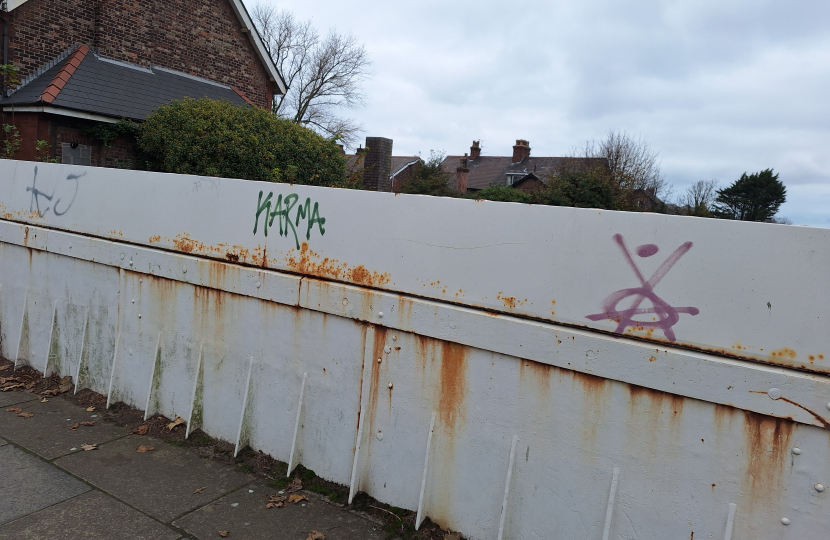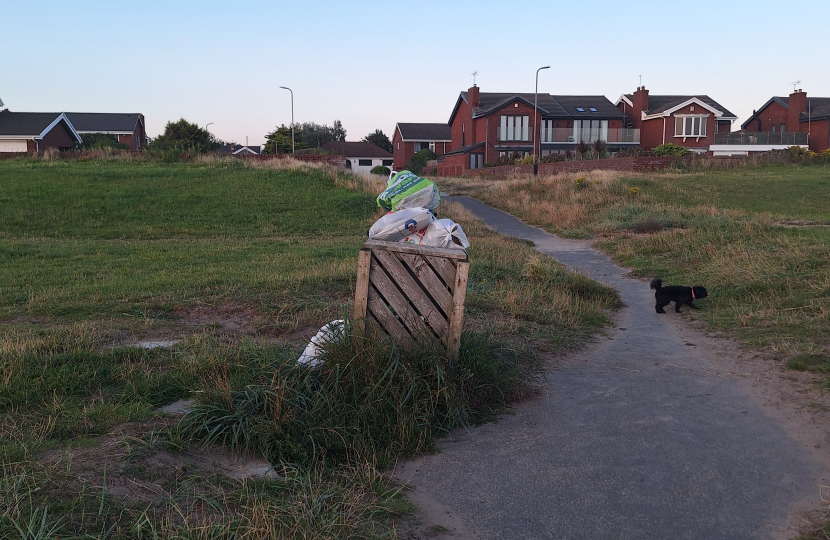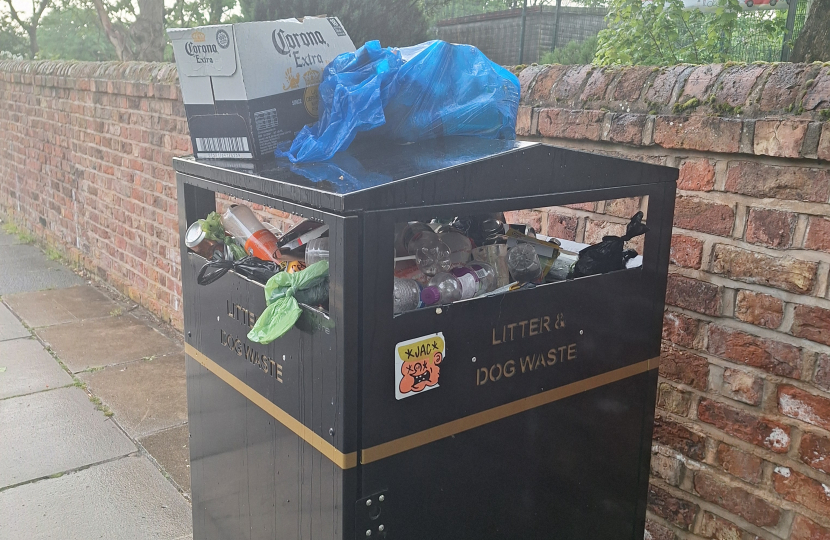Looking back at some of Sefton’s Labour Party election material, one of the pledges that were portrayed was to take back control of our streets. This could be construed
to be concerned with antisocial behaviour, damage to property; youngsters riding scrambler bikes, motor bikes or speeding drivers who use some roads as race tracks
in their high performance vehicles.
Cracking down on this behaviour is important and the police have had some considerable success in reducing these incidents. However, there is another issue
that is sadly being over looked by our Labour Councillors. Those of them that live in the area must surely be aware of the invasion of weeds along our roads and gutters
and how, in many areas, the weeds are left to flourish and flower into the summer months.
We know that weeds can grow and reproduce rapidly, especially if the weather is warm and damp. If they’re not kept under control, weeds can quickly wreak havoc in
local amenity areas and create all sorts of challenges for councils, residents and highways authorities.
Weeds are a problem on streets and roads for several reasons, including:
Appearance – Weeds littering the streets and roads can make them look unsightly, but they can also trap litter and other dirt deterring from the overall attractiveness of
an area. It makes it even more difficult for manual road sweepers to brush debris away when it is clogged with weeds.
Safety – Weeds can affect the safety of our roads and streets, by: Causing trip hazards – Weeds growing around pavements and kerbs can be trip hazards for the public but can also cause broken or uneven slabs, which can also be trip hazards.
Obscure traffic signs – Weeds and overgrown tree branches can interfere with visibility for road users by obscuring traffic signs and other signals.
Prevent drainage – Weeds around kerbs and in drains can affect the way water is drained from the streets and roads, by slowing drainage or preventing it altogether.
This can cause flooding which, in turn, increases the risk of accidents for pedestrians, cyclists and drivers. This is made worse in the autumn months with the
build-up of leaves, particularly at junctions, near to schools where pupils have to leap over hazardous mounds of rotting leaves to cross the road. This situation causes big problems for our road crossing wardens who have not only to deal with vehicles ploughing through the puddles but also assist small children as they navigate the
puddles in an effort not to get wet.
Expense – Weeds can destroy pavements, force kerbs apart, crack walls and block drains resulting in hefty maintenance costs for local authorities. Our roads and pavements look neglected and become hazardous.
What would we expect from our council?
The best way for councils to tackle weed growth is by creating a borough-wide weed treatment programme as well as an integrated weed control programme, which
includes sweeping and regular maintenance of surfaces, alongside herbicide control. In recent years, local authorities have been looking for alternative methods of
controlling weeds that reduce the amount of glyphosate applied. In Sefton, there seems a rather patchy approach to dealing with the weeds across the borough.
Glyphosate which was at one time used by all local authorities to control weed growth has been found to be potentially harmful for humans and bad for wildlife.
However, there are now alternative less harmful chemicals available but Sefton seems to be lagging behind in their use of these products and as a result many of
our footpaths and gullies are full of plant growth.
Surely there must be a way in which our council can speak to other boroughs that have been successful in reducing weed growth and gain an insight into applying best
practice to Sefton. Some of our major roads and residential streets are looking unsightly and neglected and the growth of weeds and grass is adding to flooding and
pools of water by the kerbside, making walking for pedestrians hazardous. All those residents that have gardeners that “mow, blow and go” just compile the problem.
Surely it’s not asking much for residents to pick up and brush and shovel and clear the area from in front of their house. Or do those big black gates and fences
preclude them observing the area outside their home?
LITTER
The work of The Wombles in helping to clear our streets, coastline and parks of litter has been commendable. However, our council still needs to realise that some of the
bins, especially those along the coastline are not fit for purpose. Litter placed in old, dilapidated wooden bins with no lids will be blown around by the
wind. Having no lid on the bin allows birds and vermin easy access to any food debris, which is then spilled out onto the ground. We need addition bins which are
suited to the environmental conditions that prevail in these coastal regions. A visit to Blackpool or Lytham who are highly effective in controlling litter, would
allow our council to view best practice and the appropriate design of bins. The regime for emptying these bins appears to be shrouded in mystery. It is a
thankless task for anyone to empty the bins of accumulated rubbish. During the summer months and at Bank Holidays, when footfall increases surely it would be
best practice to allocate more frequent emptying of bins, especially when they are crammed full of rubbish, often spilling onto the pavement.
One wonders how many fixed penalty notices have been successfully issued in Sefton to those who continually litter our streets. The Wombles cannot pick up all the
litter.
SUBWAYS
The saga continues with the subway at Blundellsands and Crosby station. Although there has been some painting done of the walls through National Lottery Funding
and the work of a local artist, the footpath is in a dire state. The drains which are the responsibility of Sefton Council are still blocked. This is hardly surprising as the
growth of housing within the area is obviously putting massive strain on the Victorian drainage system.
Even in dry weather the surface is wet making it an unpleasant experience walking through the area or indeed pushing a buggy or negotiating the area with a
wheelchair. Wheelchair users in particular or those with walking aids are fearful of what may adhere to the wheels of their mobility aid. The recent heavy rainfall has
had a considerable impact on the subway causing flooding and making it impossible to access the walkway until it subsides. The solution is simple. Unblock the drains,
clean away the debris and implement a regular maintenance regime. Parents with children, pedestrians using the subway just want to walk without standing in mud,
water and other forms of detritus.
GRAFFITI
Mersey Road Bridge has for some time now been the subject of graffiti. It needs removing in line with Sefton Council’s Policy. Graffiti is an act of vandalism and can
damage property and tarnishes our neighbourhood. If graffiti is left, it creates a feeling of neglect and damages the area’s reputation. Talking to residents there is a
sense of hopelessness. Trying to report it to Sefton council means a long wait on a telephone call. Using the online reporting system means having to answer questions
relating not only to your address but your sexual orientation. Most councils have access to specialise graffiti removing chemicals, which work effectively on removing
paint. Sefton Council seem to be content to use black paint!
Pedestrian Safety
The recent changes to the traffic control of Crosby village, is, we believe finally completed. The new paving brings a feeling of freshness to the area but there has
been considerable concern voiced about the lack of pedestrian safety barriers at some of the major crossing areas. The crossing on the by-pass and Liverpool Road
in particular is of considerable concern. The lack of barriers at this and other junctions does little to protect pedestrians from the “slip stream” caused by the very
large articulated trucks that turn into the roadway. Barriers shield pedestrians particularly those with young children and those with buggies and prams.
Elderly people are particularly anxious; they often lean on the barrier while waiting to cross. Those with sight impairments use their stick to judge the end of the walkway.
That facility is no longer available.
The road width has been reduced at the pedestrian crossings but this appears to compound the issue as the slip stream becomes more apparent as one stands at the
crossing. The small curb causes a trip hazard as there is no differentiation in the stone colouring. Those crucial safety issues are not apparent. Why?
It seems particularly strange when crossings elsewhere have barriers to protect pedestrians from vehicles. One of the primary advantages of pedestrian barriers is the enhanced protection they provide. These barriers act as a physical demarcation, separating pedestrians from vehicular traffic, thereby reducing the chance of accidents. Additionally pedestrians can walk or stand by the barrier with a greater sense of security and peace of mind, knowing they have some protection form the oncoming and in some cases. Perhaps in the coming months the funding for these essential barriers will be provided, improving the safety of all those wishing to cross the increasingly busy
roads.




